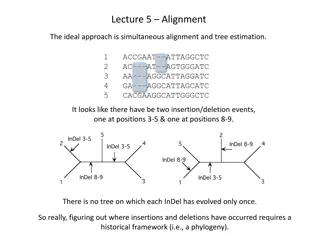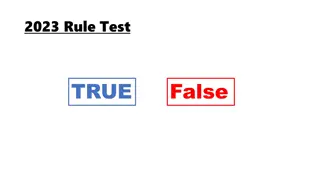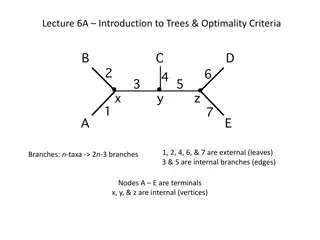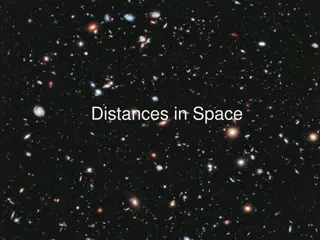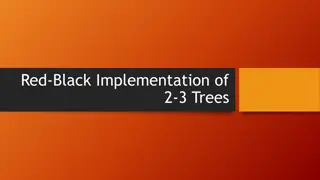Computing Triplet and Quartet Distances Between Evolutionary Trees
Study on computing triplet and quartet distances in evolutionary trees, comparing rooted vs. unrooted, binary vs. arbitrary degree trees. Discusses algorithms, experimental results, and evolutionary tree construction methods. Includes analysis on cultural phylogenetics and evolutionary tree comparisons.
Uploaded on Sep 07, 2024 | 0 Views
Download Presentation

Please find below an Image/Link to download the presentation.
The content on the website is provided AS IS for your information and personal use only. It may not be sold, licensed, or shared on other websites without obtaining consent from the author.If you encounter any issues during the download, it is possible that the publisher has removed the file from their server.
You are allowed to download the files provided on this website for personal or commercial use, subject to the condition that they are used lawfully. All files are the property of their respective owners.
The content on the website is provided AS IS for your information and personal use only. It may not be sold, licensed, or shared on other websites without obtaining consent from the author.
E N D
Presentation Transcript
Computing Triplet and Quartet Distances Between Trees Gerth St lting Brodal, Morten Kragelund Holt, Jens Johansen Aarhus University Rolf Fagerberg University of Southern Denmark Thomas Mailund, Christian N. S. Pedersen, Andreas Sand Aarhus University, Bioinformatics Research Center Work presented at SODA 2013 and ALENEX 2014 Computer Science Institute, Charles University, Prague, Czech Republic, 18 September 2014
Outline Evolutionary trees rooted vs. unrooted, binary vs. arbitrary degree Tree distances Robinson-Foulds, triplet, quartet Results and previous work triplet, quartet distances Algorithms triplet (quartet) Experimental results (ALENEX 2014)
Rooted Evolutionary Tree Time Bonobo Chimpanzee Human Neanderthal Gorilla Orangutan
Unrooted Evolutionary Tree Dominant modern approach to study evolution is from DNA analysis
Constructing Evolutionary Trees Binary or Arbitrary Degrees ? Distance matrix 1 2 3 n 1 2 3 n Sequence data 1 2 3 n Binary trees (despite no evidence in distance data) Arbitrary degree (compromise ; good support for all edges) Arbitrary degrees (strong support for all edges ; few branches) .... .... Neighbor Joining Saitou, Nei 1987 [ O(n3) Saitou, Nei 1987 ] Buneman Trees Buneman 1971 [ O(n3) Berry, Bryan 1999 ] Refined Buneman Trees Moulton, Steel 1999 [ O(n3) Brodal et al. 2003 ]
Data Analysis vs Expert Trees Binary vs Arbitrary Degrees ? Cultural Phylogenetics of the Tupi Language Family in Lowland South America. R. S. Walker, S. Wichmann, T. Mailund, C. J. Atkisson. PLoS One. 7(4), 2012. Linguistic expert classification (Aryon Rodrigues) Neighbor Joining on linguistic data
Evolutionary Tree Comparison split 8 1357|2468 2 6 7 ? 4 4 7 5 6 5 2 8 3 1 1 3 T1 T2 Common Only T1 35|124678 Only T2 57|123468 1357|2468 13567|248 48|123567 Robinson-Fouldsdistance = # non-common splits = 2 + 1 = 3 D. F. Robinson and L. R. Foulds. Comparison of weighted labeled trees. In Combinatorial mathematics, VI, Lecture Notes in Mathematics, pages 119 126. Springer, 1979. [Day 1985] O(n) time algorithm using 2 x DFS + radix sort
Robinson-Foulds Distance (unrooted trees) D. F. Robinson and L. R. Foulds. Comparison of weighted labeled trees. In Combinatorial mathematics, VI, Lecture Notes in Mathematics, pages 119 126. Springer, 1979. 3 4 3 4 6 6 8 Common Only T1 12567|348 1257|3468 157|23468 57|123468 Only T2 125678|34 12578|346 1578|2346 578|12346 78|123456 ? (none) 2 1 2 1 5 8 5 7 7 T1 T2 RF-dist(T1 , T2) = 4 + 5 = 9 RF-dist(T1\{8} , T2\{8}) = 0 Robinson-Foulds very sensitive to outliers
Quartet Distance (unrooted trees) G. Estabrook, F. McMorris, and C. Meacham. Comparison of undirected phylogenetic trees based on subtrees of four evolutionary units. Systematic Zoology, 34:193-200, 1985. Consider all n 4 quartets, i.e. topologies of subsets of 4 leaves {i,j,k,l} j l j l i k i k resolved : ij|kl unresolved : ijkl (only non-binary trees) 5 5 2 Quartet {1,2,3,4} {1,2,3,5} {1,2,4,5} {1,3,4,5} {2,3,4,5} T1 T2 1 14|23 13|25 14|25 14|35 25|34 14|23 15|23 1245 1345 23|45 3 3 4 4 2 1 T1 T2 Quartet-dist(T1 , T2) = n 4- # common quartets = 5-1 = 4
Triplet Distance (rooted trees) D. E. Critchlow, D. K. Pearl, C. L. Qian: The triples distance for rooted bifurcating phylogenetic trees. Systematic Biology, 45(3):323-334, 1996. Consider all n 3 triplets, i.e. topologies of subsets of 3 leaves {i,j,k} k i k j i j unresolved : ijk (only non-binary trees) resolved : k|ij Triplet {1,2,3} {1,2,4} {1,2,5} {1,3,4} {1,3,5} {1,4,5} {2,3,4} {2,3,5} {2,4,5} {3,4,5} T1 T2 2|13 1|24 1|25 4|13 5|13 1|45 3|24 3|25 5|24 3|45 2|13 4|12 5|12 4|13 5|13 1|45 4|23 5|23 2|45 3|45 3 1 5 5 2 4 4 2 1 T2 3 T1 Triplet-dist(T1 , T2) = n 3- # common triplets = 10 - 5 = 5
Computational Results Rooted Unrooted Quartet distance Triplet distance 5 2 3 3 1 5 4 O(n3) O(n2) 4 2 D 1985 1 O(n2) Binary CPQ 1996 BTKL 2000 O(n log2 n) O(n log n) SBFPM 2013 O(n log2n) O(n log n) BFP 2001 [SODA 2013] BFP 2003 10 5 9 3 1 8 7 3 1 5 12 11 6 7 13 4 6 2 Arbitrary degrees O(d9 n log n) O(n2.688) O(d n log n) SPMBF 2007 O(n2) O(n log n) BDF 2011 NKMP 2011 [SODA 2013] [SODA 2013] [ALENEX 2014]
Distance Computation Triplet-dist(T1 , T2) = B + C + D = n 3 A E T2 Resolved Unresolved A : Agree Resolved k C i j k B : Disagree i k i j j i j j k i k T1 Unresolved D E i k k j i j i k j i j i k j k Sufficient to compute A and E D + E and C+ E unresolved in one tree (For binary trees C, D and E are all zero)
Parameterized Triplet & Quartet Distances B + (C + D) , 0 1 T2 Resolved Unresolved A : Agree Resolved k C i j k B : Disagree i k i j j i j j k i k T1 Unresolved D E i k k j i j i k j i j i k j k BDF 2011 O(n2) for triplet, NKMP 2011 O(n2.688) for quartet [SODA 2013/ALENEX 2014] O(n log n) and O(d n log n), respectively
Counting Unresolved Triplets in One Tree v v i<j<k ni nj nk n1n2n3 nd Triplet anchored at v Computable in O(n) time using DFS + dynamic programming Quartets (root tree arbitrary) v v i<j<k<l ni nj nk nl+n i<j<k ni nj nk nl n1n2n3 nd l Quartet anchored at v
Counting Agreeing Triplets (Basic Idea) 0 v w c j j 1 i d i i T1 T2 c w+ ni c nw nc ni ni v T1 w T2 c 1 i d 2 w 1 i d ni
Efficient Computation Limit recolorings in T1 (and T2) to O(n log n) 0 v 0 0 0 0 1 T1 Recolor Recolor Recurse v v v v ... 0 1 2 v 1 d 1 1 1 (precondition) Recolor & recurse Count T2 contribution 1 Reduce recoloring cost in T2from O(n2) to O(n log2n) T2 H(T2) binary height O(log n) 7 9 8 5 arbitrary height degree 6 3 2 9 3 6 1 4 2 7 5 8 4 1 Reduce recoloring cost in T2from O(n log2n) to O(n log n) Contract T2 and reconstruct H(T2) during recursion
Counting Agreeing Triplets (II) C2 node inH(T2) = component composition in T2 T1 i j 0 i v i j C1 j i 1 i d i i j Contribution to agreeing triplets at node in H(T2) C1n(ii) C C1 ni C2+ + C1 C1 ni C2 1 i d C2 ni 1 i d n ni ni 1 i d n 2
FromO(nlog2n) to O(nlog n) Compressed version of T2 of size O(nv) Update O(1) counters for all colors through node T1 0 v H( T2) w j 1 i d ni ni lognv nv log| T2| Colored path lengths 2 i d = 2 i d ni ni Total cost for updating counters a(5) a(4) logna(j+1) na(j) = n logn T1 a(3) ancestor a(j) not heavy child a(2) leaf l T1 a(1) l=a(0)
Counting Quartets... Root T1 and T2 arbitrary Keep up to 7d2 + 97d + 29 different counters per node in H(T2)... Bottleneck in computing disagreeing resolved-resolved quartets T1 T2 0 G1 G2 v i j i j n(ij)G1 n(ij)G2 1 i<d i<j d j 1 i d double-sum factor d time
Distance Computation Triplet-dist(T1 , T2) = B + C + D = n 3 A E T2 Resolved Unresolved A : Agree Resolved k C i j k B : Disagree i k i j j i j j k i k T1 Unresolved D E i k k j i j i k j i j i k j k Sufficient to compute A and E
ALENEX 2014: Implementation (M.Sc. thesis Morten Kragelund Holt and Jens Johansen) Binary Arbitrary degree time counters time counters Triplet O(n log n) 6 O(n log n) 4d+2 O(max(d1, d2) n log n) 2d2 + 79d + 22 (B, with T1 T2) 7d2 + 97d + 29 (B, no swap) Quartet O(n log n) 40 O(min(d1, d2) n log n) d2 + 12d + 12 (E, no swap) Worst-case #counters per node in HDT(T2) First implementation for triplets for arbitrary degree Space usage 10 KB per node for quartet (binary trees) can handle 1,000,000 leaves 64 bit integers, except 128 bit integers for values > n3 quartet distance of up to 2,000,000 leaves
Experimental Results Quartet Distance Binary Trees [SODA 2013] MP 2004 NKMP 2011 [ALENEX 2014] are the first O(n log n) implementations MP 2004 overhead from working with polynomials
Experimental Results Quartet Distance High Degree Trees max [SODA 2013] NKMP 2011 d = 1024 d = 256 [ALENEX 2014] are the first n poly(log n,d) implementation
Experimental Results Triplet Distance Binary Trees [SODA 2013] SBFPM 2013 [ALENEX 2014] are the first O(n log n) implementation SBFPM 2013 only binary trees, no contractions
Experimental Results Triplet Distance High Degree Trees [SODA 2013], d = 2 [SODA 2013], d = 256 SODA 2013 [SBFPM 2013] [SODA 2013], d = 1024 [ALENEX 2014] first implementation Triplet distance appears hardest for binary trees
Summary Rooted Unrooted Quartet distance Triplet distance 5 2 O(n3) O(n2) 3 D 1985 3 1 5 4 4 2 BTKL 2000 1 O(n2) Binary CPQ 1996 O(n log2n) O(n log n) O(n log n) BFP 2001 O(n log2 n) O(n log n) SBFPM 2013 BFP 2003 [SODA 2013] [SODA 2013] o(n log n) ? 10 5 9 3 1 8 7 3 1 5 12 11 6 7 13 Arbitrary degrees 4 6 2 O(d9 n log n) O(n2.688) O(d n log n) SPMBF 2007 O(n2) O(n log n) BDF 2011 NKMP 2011 [SODA 2013] [SODA 2013] [ALENEX 2014] O(n log n) ? d = minimal degree of any node in T1 and T2 = fastest implementation for large n
References On the Scalability of Computing Triplet and Quartet Distances. M.K. Holt, J. Johansen, G.S. Brodal. ALENEX 2014. Algorithms for Computing the Triplet and Quartet Distances for Binary and General Trees. A. Sand, M.K. Holt, J. Johansen, R. Fagerberg, G.S. Brodal, C.N.S. Pedersen, T. Mailund. Biology - Special Issue on Developments in Bioinformatic Algorithms, 2013. A practical O(n log2n) time algorithm for computing the triplet distance on binary trees. A. Sand, G.S. Brodal, R. Fagerberg, C.N.S. Pedersen, T. Mailund. BMC Bioinformatics 2013. Efficient Algorithms for Computing the Triplet and Quartet Distance Between Trees of Arbitrary Degree. G.S. Brodal, R. Fagerberg, C.N.S. Pedersen, T. Mailund, A. Sand. SODA 2013. A sub-cubic time algorithm for computing the quartet distance between two general trees. J. Nielsen, A. K. Kristensen, T. Mailund, C.N.S. Pedersen. Algorithms in Molecular Biology 2011. Computing the Quartet Distance Between Evolutionary Trees of Bounded Degree. M. Stissing, C.N.S. Pedersen, T. Mailund, G.S. Brodal, R. Fagerberg. APBC 2007. QDist - Quartet Distance between Evolutionary Trees. T. Mailund and C.N. S. Pedersen. Bioinformatics 2004. Computing the Quartet Distance Between Evolutionary Trees in Time O(n log n). G.S. Brodal, R. Fagerberg, C.N.S. Pedersen. Algorithmica 2004. Computing the Quartet Distance Between Evolutionary Trees in Time O(n log2n). G.S. Brodal, R. Fagerberg, C.N.S. Pedersen. ISAAC 2001. birc.au.dk/software







